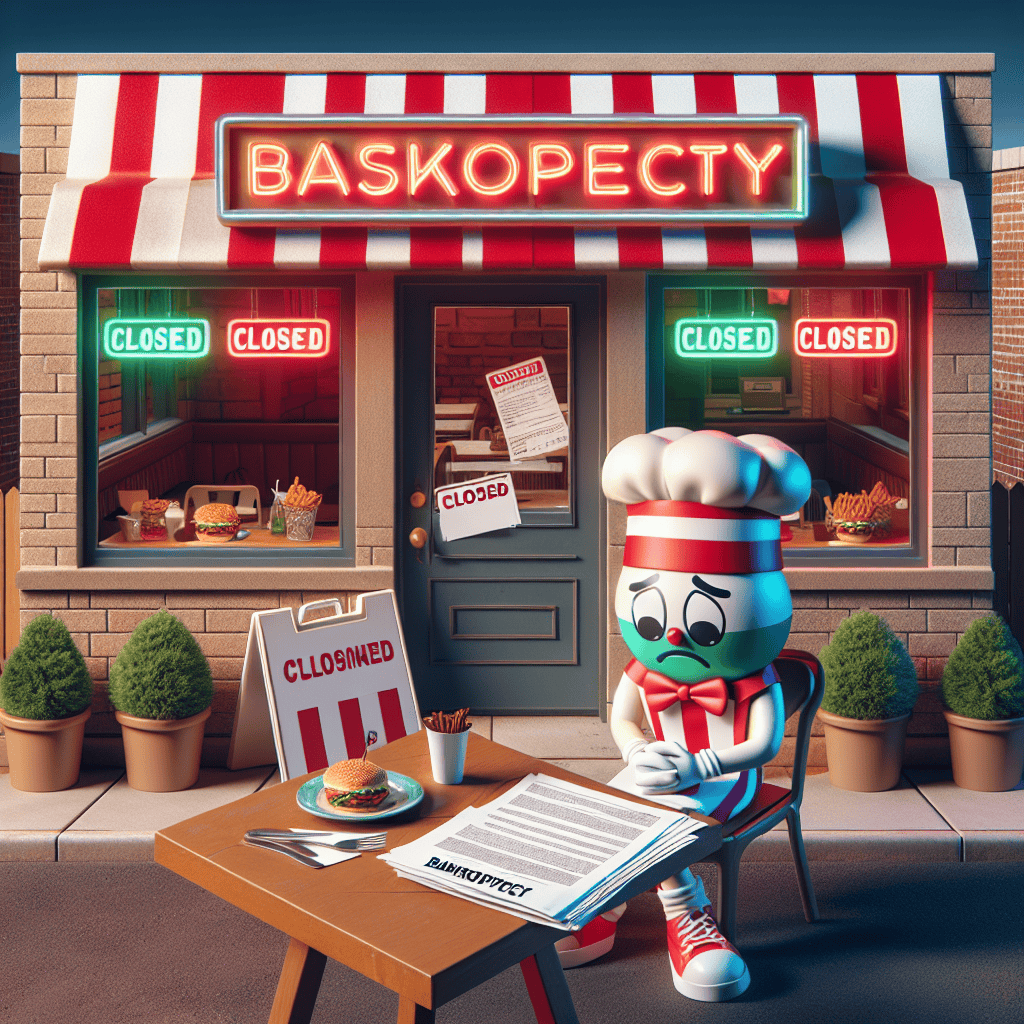“TGI Fridays Faces the Music: Navigating Bankruptcy in a Shifting Dining Landscape”
Introduction
TGI Fridays, a well-known name in the casual dining sector, has recently filed for bankruptcy protection, highlighting the ongoing struggles faced by sit-down restaurants in the current economic climate. The iconic chain, which has been a staple in the dining industry for decades, is grappling with a combination of factors that have severely impacted its financial stability. These challenges include shifting consumer preferences towards takeout and delivery, increased competition from fast-casual and quick-service restaurants, and the lingering effects of the COVID-19 pandemic, which drastically altered dining habits and reduced foot traffic. As TGI Fridays seeks to restructure its operations and financial obligations, its bankruptcy filing underscores the broader difficulties confronting traditional dine-in establishments as they strive to adapt to an evolving market landscape.
Impact Of Economic Downturn On Sit-Down Restaurants
The economic downturn has cast a long shadow over various sectors, with the sit-down restaurant industry being one of the most affected. TGI Fridays, a well-known name in casual dining, has recently sought bankruptcy protection, highlighting the ongoing challenges faced by sit-down restaurants. This move underscores the broader struggles within the industry, as economic pressures continue to reshape consumer behavior and operational dynamics.
The financial strain on sit-down restaurants has been exacerbated by several factors, including rising operational costs and changing consumer preferences. As inflation rates climb, the cost of ingredients, labor, and utilities has surged, squeezing profit margins for many establishments. TGI Fridays, like many of its counterparts, has found it increasingly difficult to balance these rising costs while maintaining competitive pricing for its customers. Consequently, the decision to seek bankruptcy protection is a strategic move aimed at restructuring its financial obligations and ensuring long-term viability.
Moreover, the shift in consumer behavior has further complicated the landscape for sit-down restaurants. The pandemic accelerated the adoption of takeout and delivery services, with many consumers now favoring the convenience of dining at home. This shift has led to a decline in foot traffic for traditional sit-down establishments, forcing them to adapt to a new reality. TGI Fridays, despite its efforts to enhance its delivery and takeout options, has struggled to match the agility of fast-casual and quick-service restaurants that are better suited to this model.
In addition to these challenges, the competitive landscape has intensified, with new entrants and innovative dining concepts capturing market share. Sit-down restaurants are now competing not only with each other but also with a plethora of alternatives that offer unique dining experiences or cater to niche markets. TGI Fridays, with its traditional casual dining model, has faced difficulties in differentiating itself in an increasingly crowded market. This has necessitated a reevaluation of its brand positioning and customer engagement strategies.
Furthermore, the labor market has posed significant challenges for the sit-down restaurant industry. The shortage of skilled labor, coupled with increasing wage demands, has made it difficult for restaurants to maintain adequate staffing levels. TGI Fridays, like many others, has had to navigate these labor market dynamics while ensuring quality service, which is critical to customer satisfaction and retention. The bankruptcy protection filing provides an opportunity to address these operational challenges and implement necessary changes to its workforce management.
Despite these hurdles, there remains a glimmer of hope for the sit-down restaurant industry. As the economy gradually recovers, there is potential for a resurgence in consumer spending and dining out. However, this recovery is contingent upon the ability of restaurants to adapt to evolving consumer expectations and economic conditions. TGI Fridays’ decision to seek bankruptcy protection is a testament to the resilience and adaptability required to navigate these turbulent times.
In conclusion, the economic downturn has undeniably impacted the sit-down restaurant industry, with TGI Fridays’ bankruptcy protection filing serving as a stark reminder of the challenges at hand. Rising operational costs, shifting consumer preferences, increased competition, and labor market constraints have all contributed to the current predicament. Nevertheless, with strategic restructuring and a focus on innovation, there is hope for a revitalized future for sit-down restaurants. As the industry continues to evolve, those that can effectively adapt will be well-positioned to thrive in the post-pandemic landscape.
TGI Fridays’ Strategic Moves To Navigate Financial Struggles
TGI Fridays, a well-known name in the casual dining sector, has recently filed for bankruptcy protection, a move that underscores the ongoing challenges faced by sit-down restaurants in an evolving dining landscape. This decision comes as part of a strategic effort to restructure its financial obligations and adapt to the changing preferences of consumers. The restaurant industry has been significantly impacted by a variety of factors, including the rise of fast-casual dining, increased competition, and shifting consumer behaviors, all of which have contributed to the financial struggles of traditional sit-down establishments like TGI Fridays.
In recent years, TGI Fridays has faced mounting pressure to remain competitive in an industry that is increasingly dominated by convenience and speed. The proliferation of fast-casual restaurants, which offer a blend of quick service and quality dining experiences, has attracted a significant portion of the market share that once belonged to traditional sit-down restaurants. As a result, TGI Fridays has been compelled to reevaluate its business model and explore new strategies to attract and retain customers. This has included efforts to modernize its menu offerings, enhance the dining experience, and leverage technology to streamline operations.
Moreover, the COVID-19 pandemic has further exacerbated the challenges faced by sit-down restaurants. With lockdowns and social distancing measures in place, many establishments were forced to close their doors temporarily or operate at reduced capacity. This led to a significant decline in revenue for TGI Fridays, as well as other similar businesses. In response, the company has sought to expand its takeout and delivery services, recognizing the growing demand for off-premise dining options. By partnering with third-party delivery platforms and investing in its own digital infrastructure, TGI Fridays aims to capture a larger share of the delivery market and offset the losses incurred from reduced in-person dining.
In addition to these operational adjustments, TGI Fridays has also been exploring financial strategies to alleviate its debt burden and improve its overall financial health. The decision to file for bankruptcy protection is a critical component of this strategy, as it allows the company to restructure its debts and negotiate more favorable terms with creditors. This legal process provides TGI Fridays with the opportunity to reorganize its business operations and emerge as a more financially stable entity. It is important to note that filing for bankruptcy protection does not necessarily mean that the company will cease operations; rather, it is a strategic move designed to facilitate long-term sustainability.
As TGI Fridays navigates this challenging period, the company remains committed to its core mission of providing a welcoming and enjoyable dining experience for its customers. By focusing on innovation and adaptability, TGI Fridays aims to position itself for future success in an increasingly competitive market. The company’s leadership is optimistic that these strategic moves will enable it to overcome its current financial struggles and continue to serve as a beloved destination for diners seeking a casual and enjoyable meal.
In conclusion, TGI Fridays’ decision to seek bankruptcy protection highlights the broader challenges faced by sit-down restaurants in today’s dynamic dining environment. Through a combination of operational adjustments and financial restructuring, the company is taking proactive steps to address its financial difficulties and adapt to changing consumer preferences. As the industry continues to evolve, TGI Fridays’ strategic initiatives will play a crucial role in determining its ability to thrive in the years to come.
The Role Of Changing Consumer Preferences In Restaurant Industry Challenges
TGI Fridays, a well-known name in the casual dining sector, has recently filed for bankruptcy protection, highlighting the ongoing challenges faced by sit-down restaurants in today’s rapidly evolving market. This development underscores a broader trend within the restaurant industry, where changing consumer preferences are reshaping the landscape and compelling traditional dining establishments to rethink their strategies. As consumer tastes and expectations continue to evolve, sit-down restaurants are finding it increasingly difficult to maintain their foothold in a market that is becoming more competitive and diverse.
One of the primary factors contributing to the struggles of sit-down restaurants like TGI Fridays is the shift in consumer preferences towards convenience and speed. In recent years, there has been a marked increase in the popularity of fast-casual dining options and food delivery services. These alternatives offer consumers the ability to enjoy a wide variety of cuisines without the time commitment associated with traditional sit-down dining. As a result, many consumers are opting for these quicker, more flexible options, leaving traditional restaurants to grapple with declining foot traffic and sales.
Moreover, the rise of technology has played a significant role in transforming consumer expectations. With the advent of food delivery apps and online ordering platforms, consumers now have unprecedented access to a multitude of dining options at their fingertips. This technological shift has not only increased competition among restaurants but has also raised the bar for customer service and convenience. Sit-down restaurants, which traditionally relied on the in-person dining experience as their primary draw, are now finding it necessary to adapt to these new consumer demands by integrating technology into their operations.
In addition to convenience, there is a growing emphasis on health and sustainability among consumers, which is influencing their dining choices. Many consumers are becoming more health-conscious and are seeking out dining options that align with their dietary preferences and values. This trend has led to an increased demand for restaurants that offer healthier menu options, locally sourced ingredients, and sustainable practices. Sit-down restaurants that fail to adapt to these changing preferences risk losing relevance in a market that is increasingly driven by consumer values.
Furthermore, the economic landscape has also played a role in shaping consumer behavior. With rising living costs and economic uncertainty, many consumers are becoming more budget-conscious and are seeking out dining options that offer better value for money. This shift has put additional pressure on sit-down restaurants, which often have higher overhead costs and, consequently, higher menu prices compared to their fast-casual counterparts. As a result, traditional dining establishments are finding it challenging to compete on price while maintaining the quality and service that consumers expect.
In light of these challenges, sit-down restaurants like TGI Fridays are being forced to reevaluate their business models and explore new strategies to remain competitive. This may involve diversifying their offerings, embracing technology, and aligning more closely with consumer values. While the road ahead may be fraught with challenges, there is also an opportunity for innovation and growth. By understanding and adapting to changing consumer preferences, sit-down restaurants can position themselves to thrive in an ever-evolving market. As the industry continues to navigate these changes, it will be crucial for traditional dining establishments to remain agile and responsive to the needs and desires of their customers.
How TGI Fridays Plans To Restructure And Revitalize Its Brand

TGI Fridays, a staple in the casual dining sector, has recently filed for bankruptcy protection, a move that underscores the ongoing challenges faced by sit-down restaurants in an evolving dining landscape. This decision comes as the company grapples with a myriad of issues, including changing consumer preferences, increased competition, and the lingering effects of the COVID-19 pandemic. However, TGI Fridays is not merely seeking to survive; it is embarking on a comprehensive restructuring plan aimed at revitalizing its brand and ensuring long-term sustainability.
To begin with, TGI Fridays plans to streamline its operations by closing underperforming locations. This strategic move is intended to reduce overhead costs and focus resources on more profitable outlets. By concentrating on high-performing locations, the company aims to enhance operational efficiency and improve customer experiences. This approach is expected to not only stabilize the financial health of the company but also create a more consistent brand image across its remaining locations.
In addition to closing certain locations, TGI Fridays is investing in the modernization of its existing restaurants. This includes updating interior designs to create a more contemporary and inviting atmosphere, which is crucial in attracting a younger demographic. The company recognizes that today’s consumers are not just looking for a meal but an experience. Therefore, by revamping its ambiance, TGI Fridays hopes to appeal to a broader audience and encourage repeat visits.
Moreover, the company is placing a significant emphasis on digital transformation. In an era where technology plays a pivotal role in consumer interactions, TGI Fridays is enhancing its digital platforms to improve customer engagement. This includes upgrading its mobile app and website to offer seamless online ordering and delivery services. By doing so, the company aims to cater to the growing demand for convenience and flexibility, which has become increasingly important in the post-pandemic world.
Furthermore, TGI Fridays is revisiting its menu offerings to better align with current food trends and consumer preferences. The company plans to introduce healthier options and expand its plant-based menu items, recognizing the shift towards more health-conscious dining choices. By diversifying its menu, TGI Fridays seeks to attract a wider range of customers, including those who may have previously overlooked the brand due to dietary preferences.
In tandem with these changes, TGI Fridays is also focusing on strengthening its marketing efforts. The company intends to leverage social media and digital marketing campaigns to reach a larger audience and build stronger connections with its customers. By utilizing targeted advertising and engaging content, TGI Fridays aims to enhance brand visibility and foster customer loyalty.
Lastly, the company is committed to fostering a culture of innovation and adaptability. By encouraging feedback from both employees and customers, TGI Fridays hopes to remain agile and responsive to market changes. This proactive approach is essential in navigating the uncertainties of the restaurant industry and ensuring the brand remains relevant in the years to come.
In conclusion, while TGI Fridays faces significant challenges, its comprehensive restructuring plan reflects a commitment to revitalizing its brand and adapting to the changing dining landscape. By focusing on operational efficiency, digital transformation, menu innovation, and strategic marketing, the company aims to emerge from bankruptcy protection stronger and more resilient. As TGI Fridays embarks on this journey of transformation, it remains to be seen how these efforts will resonate with consumers and impact the future of this iconic brand.
The Future Of Casual Dining In A Post-Pandemic World
TGI Fridays, a staple in the casual dining sector, has recently filed for bankruptcy protection, highlighting the ongoing challenges faced by sit-down restaurants in a post-pandemic world. This development underscores the broader struggles within the industry, as many establishments grapple with shifting consumer preferences, rising operational costs, and the lingering effects of the COVID-19 pandemic. As the landscape of casual dining continues to evolve, it is crucial to examine the factors contributing to these challenges and explore potential pathways for the future of this beloved dining format.
The pandemic has undeniably reshaped the dining habits of consumers, with a significant shift towards takeout and delivery services. This change has been driven by convenience and safety concerns, as well as the proliferation of food delivery apps that have made it easier than ever for consumers to enjoy restaurant-quality meals at home. Consequently, sit-down restaurants like TGI Fridays have faced declining foot traffic, forcing them to adapt their business models to remain competitive. Many have expanded their delivery and takeout options, but these efforts have not always been sufficient to offset the loss of in-person dining revenue.
Moreover, the economic impact of the pandemic has led to increased operational costs for restaurants. Supply chain disruptions have resulted in higher prices for ingredients, while labor shortages have driven up wages. These factors have placed additional financial strain on establishments already struggling to recover from the pandemic’s initial blow. For TGI Fridays, these challenges have been compounded by the need to invest in technology and infrastructure to support new service models, such as contactless payment systems and enhanced online ordering platforms.
In addition to these operational hurdles, casual dining restaurants must also contend with changing consumer preferences. Today’s diners are increasingly seeking unique and personalized experiences, often favoring local, independent eateries over large chains. This trend has been fueled by a growing interest in sustainability and a desire to support community businesses. As a result, chains like TGI Fridays must find ways to differentiate themselves and appeal to a more discerning customer base. This may involve revamping menus to include more diverse and health-conscious options or creating more engaging and immersive dining environments.
Despite these challenges, there are opportunities for sit-down restaurants to thrive in the post-pandemic world. Embracing technology can play a pivotal role in enhancing the dining experience and streamlining operations. For instance, the use of data analytics can help restaurants better understand customer preferences and tailor their offerings accordingly. Additionally, investing in digital marketing strategies can help attract new customers and retain existing ones by fostering a sense of community and connection.
Furthermore, collaboration and innovation within the industry can lead to new business models that cater to evolving consumer demands. For example, some restaurants have experimented with hybrid models that combine elements of fast-casual and full-service dining, offering the convenience of quick service with the ambiance of a sit-down restaurant. Others have explored partnerships with local farms and suppliers to provide fresh, locally sourced ingredients, appealing to environmentally conscious diners.
In conclusion, while the challenges facing sit-down restaurants like TGI Fridays are significant, they are not insurmountable. By adapting to changing consumer preferences, leveraging technology, and embracing innovative business models, casual dining establishments can navigate the complexities of the post-pandemic world and continue to play a vital role in the culinary landscape. As the industry evolves, those that are able to balance tradition with innovation will be best positioned to succeed in the years to come.
Lessons From TGI Fridays’ Bankruptcy Filing For Other Restaurant Chains
TGI Fridays’ recent bankruptcy filing serves as a cautionary tale for the restaurant industry, particularly for sit-down dining establishments facing similar challenges. The iconic chain, once a staple of American casual dining, has struggled to adapt to the rapidly changing landscape of consumer preferences and economic pressures. As other restaurant chains observe TGI Fridays’ predicament, there are several lessons to be gleaned that could help them navigate these turbulent times.
First and foremost, the importance of adaptability cannot be overstated. TGI Fridays, like many of its peers, was slow to pivot in response to the growing demand for delivery and takeout options. As consumer habits shifted, particularly during the COVID-19 pandemic, the reliance on traditional dine-in experiences became a liability. Restaurants that have successfully weathered the storm have embraced technology and diversified their service models to include robust online ordering systems and partnerships with delivery platforms. This flexibility not only caters to current consumer demands but also positions these businesses to better handle future disruptions.
Moreover, the significance of understanding and responding to consumer trends is another critical takeaway. TGI Fridays’ menu, while once innovative, failed to evolve in line with the increasing consumer preference for healthier and more diverse food options. Other chains can learn from this by continuously analyzing market trends and customer feedback to refine their offerings. Incorporating plant-based options, locally sourced ingredients, and international flavors can attract a broader customer base and keep the menu fresh and appealing.
Financial management also plays a crucial role in the sustainability of restaurant chains. TGI Fridays’ financial struggles highlight the need for prudent fiscal strategies, especially in an industry characterized by thin margins. Chains must focus on optimizing operational efficiencies, such as reducing food waste, managing labor costs, and negotiating favorable terms with suppliers. Additionally, maintaining a healthy balance sheet with manageable debt levels can provide the necessary cushion to withstand economic downturns and unforeseen challenges.
Another lesson lies in the importance of brand differentiation. TGI Fridays, once known for its vibrant atmosphere and unique offerings, gradually lost its distinct identity amid a sea of competitors. For other chains, establishing and maintaining a strong brand identity is essential. This involves not only delivering consistent quality and service but also creating a memorable dining experience that resonates with customers. Whether through unique decor, signature dishes, or exceptional customer service, a well-defined brand can set a restaurant apart in a crowded market.
Furthermore, the role of leadership and corporate culture should not be underestimated. Effective leadership that fosters a positive and adaptive corporate culture can drive innovation and resilience. Encouraging open communication, empowering employees, and fostering a culture of continuous improvement can lead to more agile decision-making and a more engaged workforce. This, in turn, can enhance customer satisfaction and loyalty, which are vital for long-term success.
In conclusion, TGI Fridays’ bankruptcy filing underscores the myriad challenges facing sit-down restaurant chains today. By learning from TGI Fridays’ experiences, other chains can better position themselves to thrive in an ever-evolving industry. Embracing adaptability, staying attuned to consumer trends, practicing sound financial management, differentiating their brand, and cultivating strong leadership and corporate culture are all essential strategies for navigating the complexities of the modern dining landscape. As the industry continues to evolve, those who heed these lessons will be better equipped to face the future with confidence.
The Influence Of Delivery And Takeout Trends On Sit-Down Restaurants
In recent years, the restaurant industry has experienced a seismic shift, driven largely by the burgeoning popularity of delivery and takeout services. This transformation has had profound implications for traditional sit-down establishments, which have struggled to adapt to the rapidly changing landscape. TGI Fridays, a well-known name in the casual dining sector, has recently sought bankruptcy protection, highlighting the challenges faced by sit-down restaurants in an era increasingly dominated by convenience and speed.
The rise of delivery and takeout services can be attributed to several factors, including technological advancements and changing consumer preferences. The proliferation of food delivery apps such as Uber Eats, DoorDash, and Grubhub has made it easier than ever for consumers to enjoy restaurant-quality meals from the comfort of their homes. This convenience has become particularly appealing in today’s fast-paced world, where time is often at a premium. As a result, many consumers now prioritize quick and easy dining options over the traditional sit-down experience.
Moreover, the COVID-19 pandemic accelerated this trend, as lockdowns and social distancing measures forced restaurants to pivot to delivery and takeout models to survive. Even as restrictions have eased, many consumers have retained their preference for these services, having grown accustomed to the convenience they offer. This shift in consumer behavior has placed significant pressure on sit-down restaurants, which have historically relied on in-person dining to drive revenue.
TGI Fridays, once a staple of the casual dining scene, has not been immune to these challenges. The brand, known for its vibrant atmosphere and extensive menu, has struggled to maintain its relevance in a market increasingly dominated by delivery and takeout options. The decision to seek bankruptcy protection underscores the difficulties faced by sit-down restaurants in adapting to the new dining paradigm. While TGI Fridays has made efforts to expand its delivery and takeout offerings, these initiatives have not been sufficient to offset the decline in in-person dining.
In addition to the rise of delivery and takeout services, sit-down restaurants like TGI Fridays face competition from a growing number of fast-casual establishments. These venues offer a middle ground between fast food and traditional sit-down dining, providing high-quality meals with the added convenience of quick service. This model has proven particularly appealing to younger consumers, who value both quality and efficiency. As a result, fast-casual restaurants have captured a significant share of the market, further eroding the customer base of traditional sit-down establishments.
Despite these challenges, there are opportunities for sit-down restaurants to adapt and thrive in this new environment. Embracing technology, for instance, can help streamline operations and enhance the customer experience. Implementing digital ordering systems and optimizing delivery logistics can enable sit-down restaurants to compete more effectively with delivery-focused competitors. Additionally, focusing on unique dining experiences that cannot be replicated through delivery or takeout can help differentiate sit-down establishments from their fast-casual and delivery-centric counterparts.
In conclusion, the influence of delivery and takeout trends on sit-down restaurants is undeniable, as evidenced by TGI Fridays’ recent financial struggles. While the challenges are significant, there are pathways for traditional dining establishments to navigate this evolving landscape. By embracing innovation and focusing on their unique strengths, sit-down restaurants can find ways to remain relevant and successful in an increasingly competitive market.
Q&A
1. **What led TGI Fridays to seek bankruptcy protection?**
TGI Fridays sought bankruptcy protection due to financial struggles exacerbated by declining customer traffic, increased competition, and the impact of the COVID-19 pandemic on the restaurant industry.
2. **How has the COVID-19 pandemic affected sit-down restaurants like TGI Fridays?**
The pandemic led to reduced dine-in customers, temporary closures, and increased operational costs, significantly impacting revenue for sit-down restaurants.
3. **What strategies has TGI Fridays implemented to address its financial challenges?**
TGI Fridays has focused on expanding delivery and takeout services, optimizing its menu, and closing underperforming locations to cut costs.
4. **How has increased competition affected TGI Fridays?**
The rise of fast-casual dining and delivery services has diverted customers away from traditional sit-down restaurants, impacting TGI Fridays’ market share.
5. **What role did changing consumer preferences play in TGI Fridays’ financial difficulties?**
Consumers increasingly prefer convenience and healthier options, which has led to a decline in visits to traditional sit-down chains like TGI Fridays.
6. **What are the potential outcomes of TGI Fridays’ bankruptcy protection filing?**
Potential outcomes include restructuring debt, renegotiating leases, closing more locations, or finding a buyer to help stabilize the business.
7. **How might TGI Fridays’ bankruptcy impact its employees?**
Employees may face job insecurity due to potential store closures and restructuring efforts, which could lead to layoffs or reduced hours.
Conclusion
TGI Fridays’ decision to seek bankruptcy protection highlights the significant challenges faced by sit-down restaurants in the current economic climate. The industry has been grappling with shifting consumer preferences, increased competition from fast-casual and delivery services, and the lingering impacts of the COVID-19 pandemic. These factors have strained financial resources and operational capacities, leading to a reevaluation of business models and strategies. TGI Fridays’ move underscores the need for traditional dining establishments to innovate and adapt to changing market dynamics to ensure long-term viability and success.





